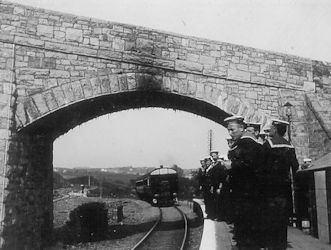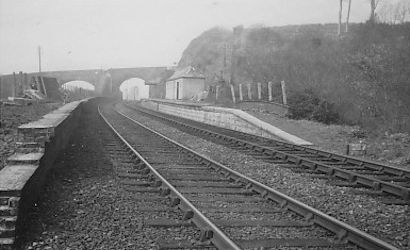|
OLD DEVONPORT
. UK |
||
|
© Brian
Moseley, Plymouth Webpage created: August 11, 2018 Webpage updated: April 14, 2021 |
||
|
RAILWAYS IN OLD DEVONPORT |
GREAT WESTERN
RAILWAY COMPANY DEFIANCE HALT / DEFIANCE PLATFORM Defiance Halt (or "Halte" as it was then) was opened by the Great Western Railway Company on the afternoon of Wednesday February 22nd 1905. Shortly after a ceremony in which Mrs Fowler, wife of Captain Fowler, of HMS "Defiance", pulled aside a white ensign, a rail motor pulled in to collect the first passengers for Plymouth. Rear-Admiral and Mrs Robinson, attended the short ceremony and the Great Western Railway Company was represented by Chief Inspector Scantlebury.
Defiance Halt, while still a single platform
(1905), It was inspected by Colonel Yorke of the Board of Trade on March 24th 1905, who reported that the Halt had been constructed by the Royal Navy for the benefit officers and sailors from HMS "Defiance", moored off Wearde Quay. He stated in his report that the single platform was 150 feet in length by 6 feet in width and was reached by two paths, one for the general public and the other for the Naval personnel from their private landing place. An announcement supplied by Mr Bryan Gibson, of Plymouth, indicates that the Halte was not opened to public passenger traffic until March 1st 1905, when the 6.46am Rail Motor from Plymouth Station (Millbay) was timed to arrive at Defiance Halte at 7.03am and depart again for Plymouth at 7.10am. Subsequent trains for Plymouth departed at 9.10am, 11.23am, 12.22pm, 2.42pm, 3.31pm, 4.35pm, 6.27pm, 9.12pm and 11.32pm. On Sundays four train were timed to depart the Halte at 2.57pm,4.57pm, 6.57pm and 9.07pm. In addition to these Rail Motors, the 7.30am train from Saint Germans to Plymouth also stopped at Defiance Halte. Following the doubling and realignment of the main line between Saltash Station and Saint Germans Station, a double platform Halt was constructed on the new line. The platforms were 350 feet each in length and 7 feet in width, each accessed off a new road bridge at the eastern end of the platforms. The new stopping place was inspected by Colonel Yorke, who gave permission for it to be opened. In the meantime, the original Defiance Halt was upgraded to Defiance Platform on and as from May 1st 1906. The late Mr C R Clinker claimed that the Platform was staffed in 1907. On the evening of Saturday November 10th 1906 Chief Petty Officer Frederick William Forward, a torpedo instructor aboard HMS "Defiance", was killed while walking on the railway line between Saltash Station and what was still referred to as Defiance Halt. His mangled body was found at about 9pm by Mr Samuel J Brimming, a messenger aboard HMS "Defiance". After watching a football match at Home Park between Plymouth Argyle and West Ham, CPO Forward and Leading Seaman William Henry Martin, also of HMS "Defiance", had caught a rail motor at Ford Halt on their way back to the ship but had to detrain at Saltash Station, where the train terminated. While Mr Martin decided to go for a drink and then catch the next train at around 9pm, CPO Forward decided to walk along the railway line as a short cut. He was declared to have been totally sober. At 8.34pm the 3.30pm train from London Paddington Station, the 8.18pm train from Plymouth Station (Millbay), left Saltash Station for Saint Germans Station, its next stop, with driver Henry C Brean in charge. At the inquest he stated that the train passed Defiance Halt at about 15mph but he felt no jolt or found any blood on the engine when he inspected it. The Coroner, giving the verdict of "Accidental Death while trespassing on the railway line", stated 'that the line was a very curved one and particularly dangerous in the dark'. CPO Forward's widowed mother lived at Port Mellen, Mevagissey, Cornwall, and his brother was a guard on the Great Western Railway Company's Launceston Branch. The naval funeral took place on Wednesday November 14th 1906 at Plymouth Cemetery. It is thought that the new Defiance Platform was not brought in to use until the replacement Forder Viaduct was opened in 1908. Defiance Platform was closed on and as from October 27th 1930.
Defiance Halt sometime after closure. The platforms were often used for the loading of flowers and market garden produce right up until the opening of the Tamar Road Bridge in 1962.
|
||

